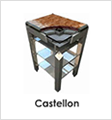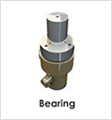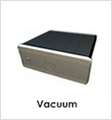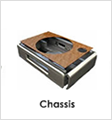


Caliburn Chassis |
Caliburn Chassis
Unique Magnesium Alloy
The Caliburn uses a unique Magnesium Alloy chassis.
The distinctive positioning of the mounting feet has been calculated to allow the bearing to dissipate energy.
In our computer modelling we predicted that placing the feet at the edge of the plinth would encourage severe vibrational modes to propagate through the chassis. This highlighted flaws in the prior art.
An example is walking along a suspension or rope bridge. You feel the reflected energy of your footsteps coming back as the energy waves are reflected back at you.
In contrast if you walk on a more solid bridge each footstep is dissipated into the infrastructure. Using the right shape and materials you can absorb this energy.
By placing the feet under the chassis to support the bearing we were able to minimize the spring force (Youngs Modulus) being reflected back into the platter from the chassis reacting to the up/down vibration modes.
Computer Modelling
The placement of the feet has been further optimized by the use of advanced computer modelling so that the remaining reflections that still occur do not refocus near the bearing.
To find these points without computer assistance is extremely time consuming (but possible) but would require many holes to be drilled into a chassis eventually compromising the integrity of the material.
Using computer-modelling software, we could bypass these traditional experimental approaches to get it right first time.
Damping
Other features of the chassis include critical applications of damping compounds and the ability to isolate the armboard even further in both the vertical and horizontal planes.
Almost every spring or elastomer-based design has significantly better vertical than horizontal isolation. Without nearly equal isolation in both planes, serious compromise is inevitable for any turntable system.
As a result, “flanking paths” can be created, allowing horizontal resonance to impair the overall isolation effectiveness of a suspension. The reactive damping that is inherent in most spring and elastomer systems can also exacerbate “Flanking”.
The Audiophile Result
The audiophile result was a platter support platform that works in harmony with the platter whilst minimizing the affects of floor borne and airborne vibrations.
This resulted in a significant improvement in depth of field and soundstage height (one can hear into the cavernous expanse of Carnegie Hall or the Palais Theatre with such realism it is frightening). Side to side and up and down motion in a cartridge generates signals, which are trying to reproduce stage width and depth of field.
A platter/chassis that bounces (even microscopically) in these modes blurs the definition of these audible cues and lowers the resolution of the system.
|










